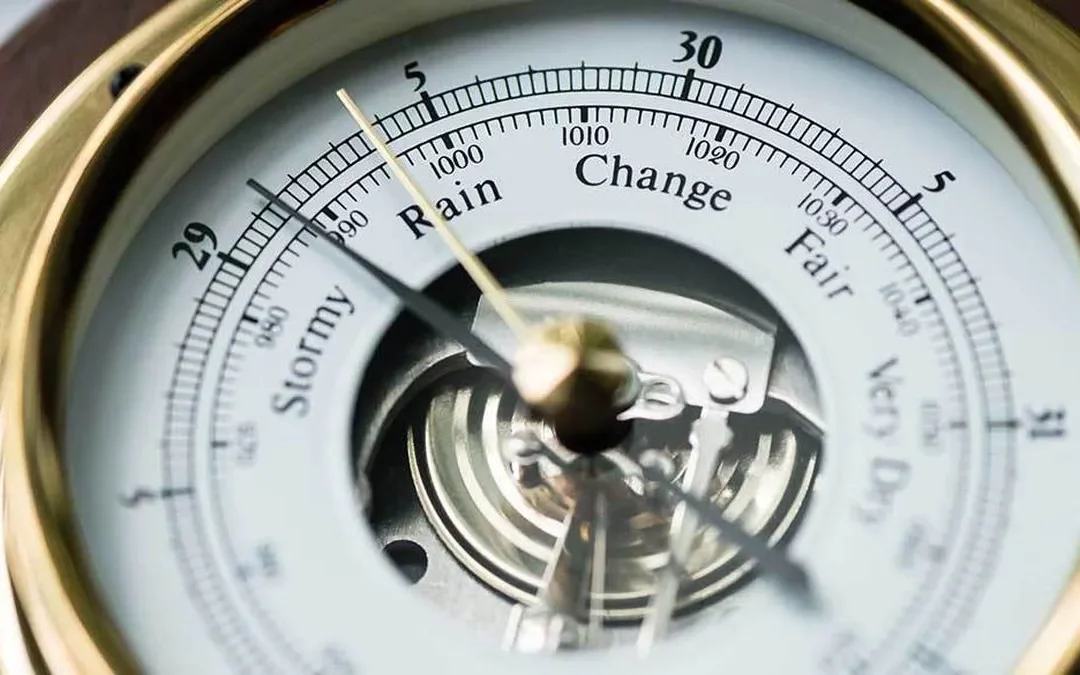
by Barani Chettiar | May 13, 2024 | Uncategorized
Atmospheric pressure, though invisible, plays a pivotal role in shaping weather patterns and influencing the behavior of the Earth’s atmosphere. For sailors and mariners navigating the open seas, understanding atmospheric pressure is crucial for predicting weather changes and ensuring safe voyages. In this article, we’ll delve into the concept of atmospheric pressure, its significance in weather forecasting, and its relation to marine barometers, essential instruments used by sailors to monitor atmospheric conditions at sea.
Understanding Atmospheric Pressure:
Atmospheric pressure refers to the force exerted by the weight of the air molecules in the Earth’s atmosphere on a unit area of the Earth’s surface. It is commonly measured in units such as millibars (mb) or inches of mercury (inHg). Atmospheric pressure varies with altitude, temperature, and weather systems, with higher pressure typically associated with fair weather and lower pressure with stormy conditions.
Causes of Atmospheric Pressure Variations:
Several factors contribute to variations in atmospheric pressure, including:
- Temperature: Warm air tends to expand and rise, creating areas of low pressure, while cold air contracts and sinks, resulting in areas of high pressure.
- Altitude: Atmospheric pressure decreases with increasing altitude, as the weight of the air above diminishes.
- Weather Systems: Low-pressure systems, such as cyclones and hurricanes, are associated with rising air and stormy weather, while high-pressure systems are associated with sinking air and fair weather.
Measurement Units and Methods:
Atmospheric pressure is measured using instruments called barometers. Common units of measurement include millibars (mb), inches of mercury (inHg), and hectopascals (hPa). Barometers may utilize mercury, aneroid, or electronic sensors to measure atmospheric pressure, with each method offering its advantages in terms of accuracy, reliability, and ease of use.
Relation to Marine Barometers:
Marine barometers are specialized instruments designed to measure atmospheric pressure in the maritime environment. They operate on the same principles as standard barometers but are engineered to withstand the harsh conditions encountered at sea, including exposure to saltwater, humidity, and constant motion. Marine barometers provide sailors and mariners with real-time measurements of atmospheric pressure, enabling them to monitor changes in weather patterns and make informed decisions about navigation and route planning.
How Marine Barometers Work:
Marine barometers typically utilize an aneroid mechanism or electronic sensor to measure atmospheric pressure. As atmospheric pressure changes, the mechanism or sensor responds accordingly, indicating the changes on a calibrated scale. By monitoring fluctuations in atmospheric pressure over time, sailors can anticipate shifts in weather conditions and take appropriate action to ensure the safety of their vessel and crew.
Importance for Sailors and Mariners:
Marine barometers are essential tools for sailors and mariners, providing valuable insights into current and future weather conditions at sea. By accurately measuring atmospheric pressure, marine barometers enable sailors to anticipate storms, adjust their sailing plans, and navigate safely through challenging waters. They are indispensable instruments for ensuring the safety and efficiency of maritime operations.
In conclusion, understanding atmospheric pressure is essential for sailors and mariners navigating the open seas. Atmospheric pressure variations influence weather patterns and have a direct impact on maritime conditions. Marine barometers play a crucial role in monitoring atmospheric pressure at sea, providing sailors with valuable information for weather forecasting and navigation. By measuring atmospheric pressure accurately and reliably, marine barometers help ensure the safety and success of voyages on the open seas.
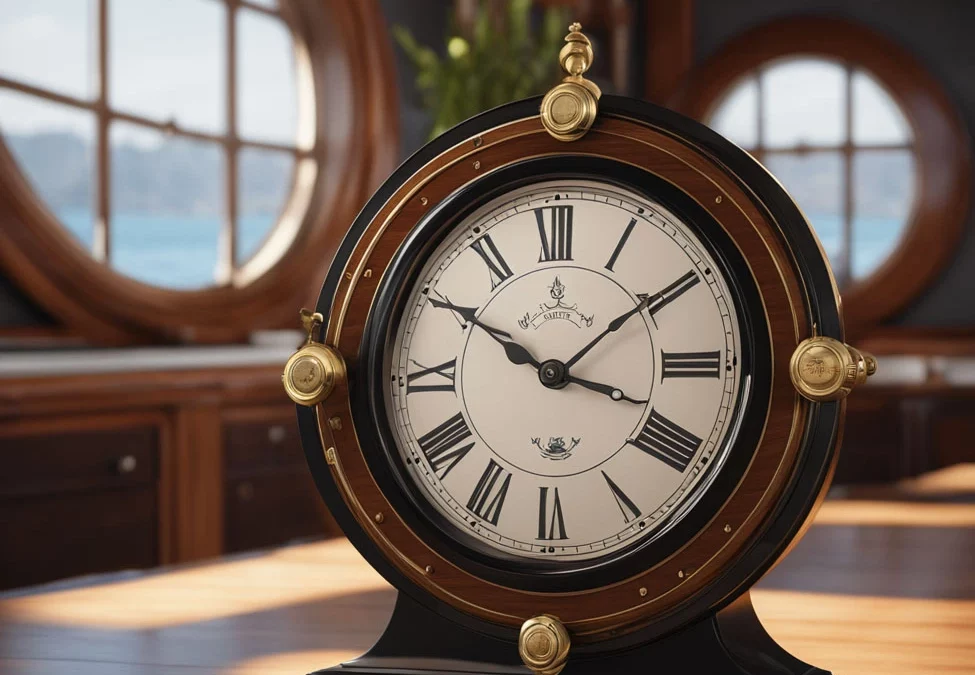
by Barani Chettiar | May 11, 2024 | Uncategorized
Introduction: Importance of Marine Clocks on Vessels
On the vast expanse of the open seas, where timekeeping is not just a matter of convenience but a necessity for safe navigation, having a reliable marine clock onboard your vessel is essential. Marine clocks serve as more than just timepieces; they are crucial instruments for maintaining accurate time and coordinating activities on board. In this guide, we’ll explore the different types of marine clocks, considerations for choosing the right one for your vessel, features to look for, popular brands, and installation and maintenance tips.
Types of Marine Clocks:
- Analog vs. Digital: Marine clocks come in two primary display formats: analog and digital. Analog clocks feature traditional clock faces with hour and minute hands, providing a classic aesthetic and ease of reading at a glance. Digital clocks, on the other hand, display time numerically, offering precision and accuracy in a modern format.
- Quartz vs. Mechanical: Marine clocks can also be categorized based on their internal mechanisms. Quartz clocks utilize quartz crystals to regulate timekeeping, offering high accuracy and reliability with minimal maintenance. Mechanical clocks, on the other hand, rely on intricate mechanical movements to keep time, offering a traditional appeal but requiring periodic winding and maintenance.
Considerations for Choosing:
- Size and Mounting Options: Consider the available space on your vessel and choose a clock size and mounting option that fits your needs. Wall-mounted, bulkhead-mounted, and standalone options are available to suit different preferences and vessel configurations.
- Accuracy and Durability: Opt for a marine clock known for its accuracy and durability, capable of withstanding the harsh marine environment, including exposure to saltwater, humidity, and vibrations.
- Style and Design: Choose a clock that complements the aesthetic of your vessel and reflects your personal style preferences. Whether you prefer a classic nautical design or a sleek, modern look, there are marine clocks available to suit every taste.
Features to Look For:
- Water Resistance: Ensure that the marine clock you choose is water-resistant or waterproof to withstand exposure to moisture and splashing on deck.
- Illumination: Look for clocks with built-in illumination or backlit displays for enhanced visibility in low-light conditions or during night-time navigation.
- Time Zone Adjustability: Consider clocks with adjustable time zone settings to accommodate changes in location or time zones during your voyage.
Popular Marine Clock Brands:
- Chelsea Clock Company
- Weems & Plath
- Wempe
- VDO
- Autonautic Instrumental
Installation and Maintenance Tips:
- Follow manufacturer instructions for proper installation to ensure accurate timekeeping and reliable performance.
- Regularly inspect and clean the clock to remove dust, debris, and salt residue that may affect its operation.
- Check and replace batteries or perform maintenance on mechanical movements as needed to keep the clock running smoothly.
Conclusion: Choose a Reliable, Functional Marine Clock
In conclusion, selecting the right marine clock for your vessel is essential for maintaining accurate timekeeping and enhancing the functionality and aesthetics of your onboard environment. By considering factors such as display type, mechanism, size, mounting options, accuracy, durability, and features, you can choose a clock that meets your specific needs and preferences. Whether you opt for a traditional analog quartz clock or a modern digital model, investing in a reliable and functional marine clock will ensure smooth sailing and efficient navigation on every voyage.
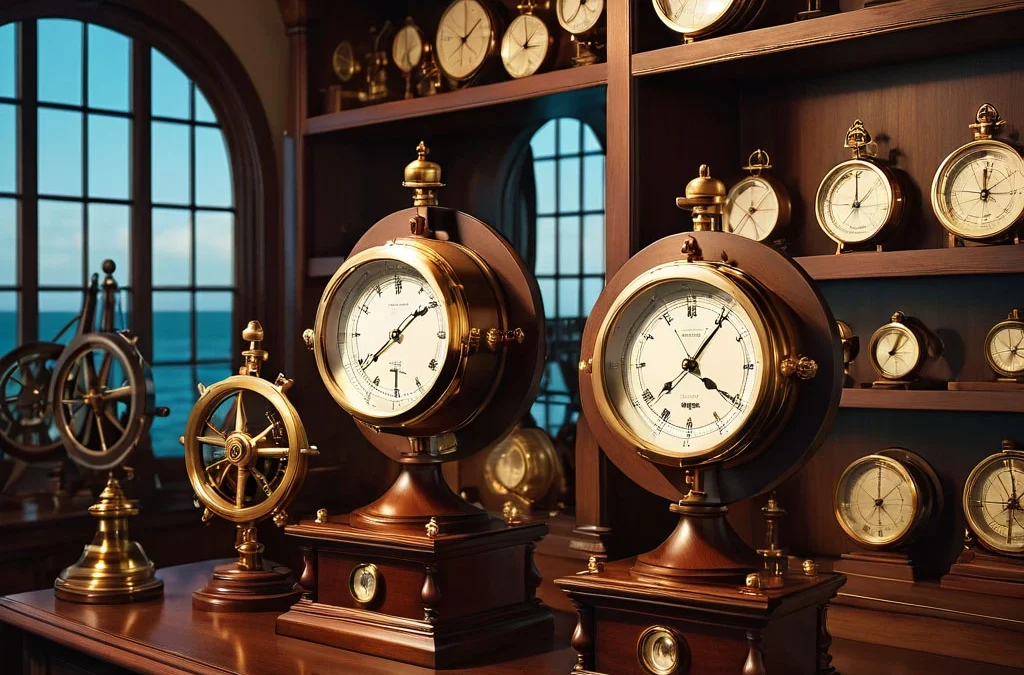
by Barani Chettiar | May 10, 2024 | Uncategorized
Introduction:
Before the advent of modern navigation technologies, sailors relied on a myriad of methods to traverse the world’s oceans, often with little certainty about their exact position. One of the most significant advancements in maritime history came with the invention of marine clocks, which revolutionized navigation and reshaped the course of exploration. In this article, we’ll delve into the fascinating history and evolution of marine clocks, tracing their development from rudimentary timekeeping devices to precision instruments that played a pivotal role in maritime exploration and beyond.
Early Navigation Techniques:
In ancient times, mariners relied on celestial observations, landmarks, and rudimentary timekeeping devices such as sundials and hourglasses to navigate the seas. However, these methods were imprecise and often unreliable, particularly on long voyages where accurate timekeeping was crucial for determining longitude.
Invention of Marine Chronometers:
The breakthrough in maritime timekeeping came in the 18th century with the invention of the marine chronometer by English clockmaker John Harrison. Harrison’s chronometers were highly accurate mechanical timepieces designed to maintain precise timekeeping despite the motion and temperature variations encountered at sea. By accurately measuring time, chronometers enabled sailors to calculate their longitude with unprecedented accuracy, revolutionizing navigation and significantly reducing the risk of shipwrecks.
Role in Maritime Exploration:
The introduction of marine chronometers played a crucial role in the age of maritime exploration, enabling sailors to venture into uncharted waters with confidence. With the ability to accurately determine their position at sea, explorers such as Captain James Cook were able to chart new territories, discover new lands, and circumnavigate the globe, opening up new trade routes and expanding the boundaries of human knowledge.
Technological Advances and Improvements:
Over the years, marine chronometers underwent significant technological advancements and improvements. Manufacturers experimented with various designs and materials to enhance their accuracy, durability, and reliability. Innovations such as bimetallic balances, temperature-compensated balances, and shock-resistant mechanisms further improved the performance of chronometers, making them indispensable tools for maritime navigation.
Decline in Use and Legacy:
Despite their revolutionary impact, the widespread adoption of electronic navigation systems such as GPS in the late 20th century led to a decline in the use of traditional mechanical chronometers. However, the legacy of marine clocks lives on, with many antique chronometers preserved in maritime museums and collections, serving as a testament to their enduring significance in maritime history.
Modern Applications and Future Prospects:
While traditional mechanical chronometers have been largely replaced by electronic devices, the principles of accurate timekeeping remain essential in modern navigation. Today, marine clocks are used in a variety of applications, from commercial shipping and maritime research to recreational boating and yachting. Additionally, advancements in technology continue to drive innovation in marine timekeeping, with the development of atomic clocks and satellite-based navigation systems further enhancing the precision and reliability of maritime navigation.
Conclusion: Impact and Significance of Marine Clocks
In conclusion, the history and evolution of marine clocks represent a remarkable journey of human ingenuity and innovation. From humble beginnings as rudimentary timekeeping devices to indispensable tools for maritime exploration and navigation, marine clocks have left an indelible mark on the course of human history. While their use may have diminished in the age of modern navigation technology, the legacy of marine clocks lives on, reminding us of their enduring impact and significance in shaping the world of maritime exploration and discovery.
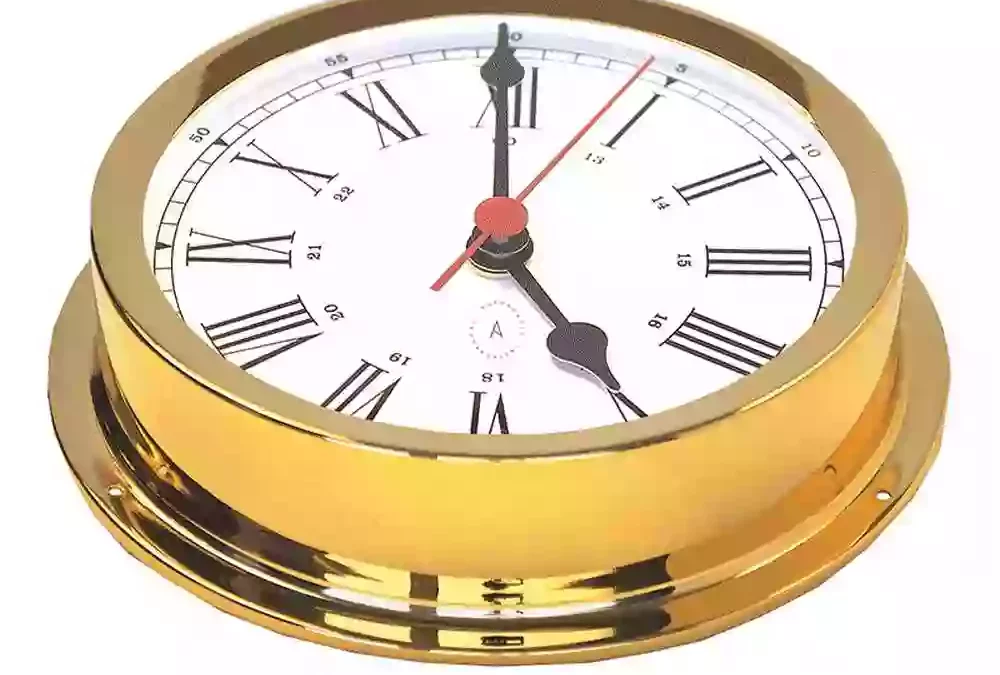
by Barani Chettiar | May 9, 2024 | Uncategorized
1. Importance of Accurate Timekeeping on the Water
In the realm of boating and maritime navigation, precise timekeeping is not just a matter of convenience; it’s a fundamental aspect of safety and efficiency. From coordinating maneuvers to calculating positions and monitoring tidal patterns, accurate timekeeping is essential for successful navigation on the water. Whether sailing across vast oceans or navigating through intricate waterways, boaters rely on marine clocks to keep track of time and ensure smooth and coordinated operations.
2. History of Marine Clocks
The history of marine clocks is intertwined with the history of seafaring itself. In the early days of maritime exploration, accurate timekeeping at sea was a formidable challenge. Traditional clocks were prone to inaccuracies caused by the motion of the vessel and fluctuations in temperature and humidity. However, the development of specialized marine clocks, such as chronometers and deck watches, revolutionized navigation by providing sailors with reliable timekeeping instruments capable of withstanding the rigors of life at sea.
3. Types of Marine Clocks – Chronometers, Deck Watches
Two primary types of marine clocks have been historically used for navigation:
- Chronometers: Chronometers are highly accurate mechanical timepieces specifically designed for maritime use. These precision instruments are equipped with robust mechanisms and housed in sturdy, shock-resistant cases to withstand the harsh conditions encountered at sea. Chronometers played a crucial role in determining longitude during the Age of Exploration and continue to be prized for their accuracy and reliability.
- Deck Watches: Deck watches are simpler timekeeping devices commonly used as secondary timepieces aboard ships. While not as precise as chronometers, deck watches provide reliable timekeeping for routine tasks and navigation calculations. They are typically mounted in prominent locations on the ship’s deck for easy reference by the crew.
4. Features and Benefits of Marine Clocks
Marine clocks offer several features and benefits tailored to the unique needs of boaters:
- Accuracy: Marine clocks are designed to maintain accurate timekeeping even in challenging maritime environments, ensuring reliable performance when navigating across vast distances or through adverse weather conditions.
- Durability: Built to withstand the rigors of life at sea, marine clocks are constructed from sturdy materials such as stainless steel or brass, with a shock-resistant design to withstand the vibrations and impacts encountered at sea.
- Visibility: Marine clocks feature clear, easy-to-read dials with luminous markings or backlighting for enhanced visibility in low-light conditions or during night-time navigation.
5. How to Choose the Right Marine Clock
When selecting a marine clock, consider the following factors to ensure it meets your specific needs:
- Accuracy: Choose a clock with a reliable timekeeping mechanism capable of maintaining accurate time over extended periods.
- Durability: Look for a clock constructed from robust materials such as stainless steel or brass, with a shock-resistant design to withstand the vibrations and impacts encountered at sea.
- Visibility: Opt for a clock with clear, legible markings and luminescent hands or backlighting for easy reading in all lighting conditions.
6. Maintenance Tips for Marine Clocks
To ensure the longevity and optimal performance of your marine clock, follow these maintenance tips:
- Regular Inspection: Periodically check the clock for signs of damage, corrosion, or malfunction, and address any issues promptly.
- Cleaning: Keep the clock clean and free from dirt, salt residue, and debris by wiping it down with a soft, damp cloth regularly.
- Calibration: If necessary, calibrate the clock according to manufacturer guidelines to maintain accurate timekeeping.
7. Conclusion: Marine Clocks Enhance Boating Experience
In conclusion, marine clocks are indispensable timekeeping instruments for boaters, providing accurate and reliable timekeeping essential for safe and efficient navigation on the water. From their historic role in maritime exploration to their continued use in modern-day boating, marine clocks embody the timeless tradition of precision and reliability at sea. By choosing the right marine clock and maintaining it properly, boaters can enhance their navigation experience and ensure smooth sailing on every voyage.
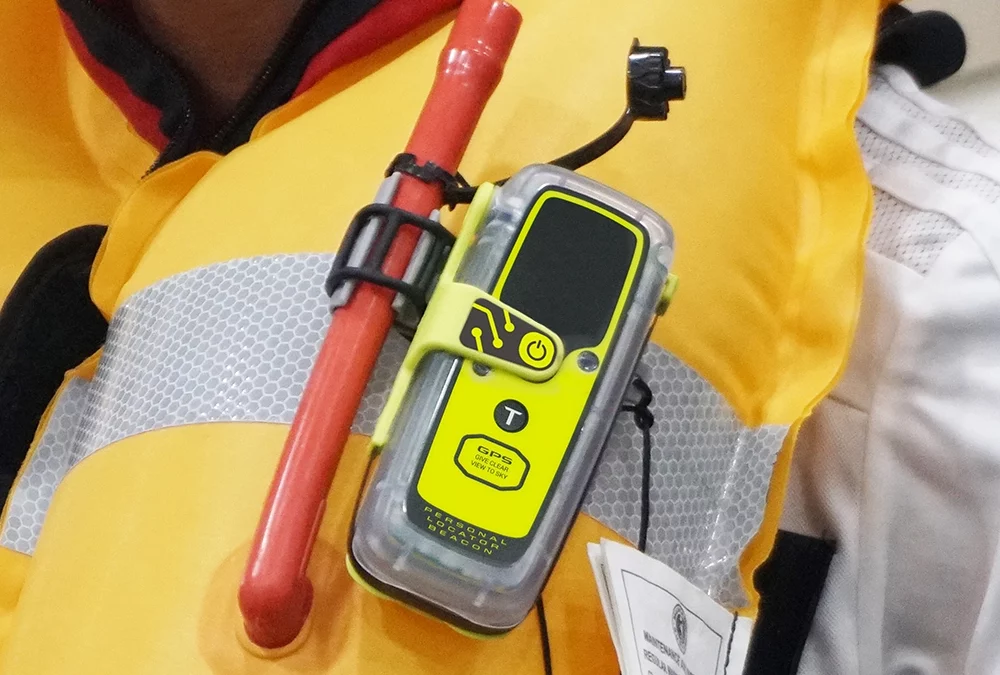
by Barani Chettiar | May 8, 2024 | Uncategorized
Introduction: Importance of PLBs in Maritime Emergencies
When facing the unpredictable and often treacherous conditions of the open sea, having access to reliable emergency signaling devices can make all the difference in ensuring a swift and effective rescue. Personal Locator Beacons (PLBs) are essential tools for maritime safety, providing individuals with a means to alert authorities to distress situations and facilitate their timely rescue. In this article, we’ll explore the functionality, benefits, regulations, and real-life success stories of PLBs in emergency situations at sea.
What are Personal Locator Beacons (PLBs)?
Personal Locator Beacons (PLBs) are compact, handheld distress signaling devices designed to transmit a distress signal on designated frequencies when activated. These devices are equipped with built-in GPS receivers, allowing them to transmit the user’s precise location to search and rescue authorities, significantly enhancing the chances of a successful rescue operation.
Functionality of PLBs in Distress Situations
In the event of an emergency at sea, activating a PLB triggers the transmission of a distress signal on internationally recognized frequencies. These signals are detected by satellite-based search and rescue systems, which relay the distress alert to ground stations and rescue coordination centers. Search and rescue teams are then dispatched to the precise location provided by the PLB to render assistance.
Benefits of Using PLBs at Sea
The use of PLBs offers several benefits in emergency situations at sea:
- Rapid Alerting: PLBs provide a rapid and reliable means of alerting search and rescue authorities to distress situations, even in remote or offshore locations where traditional communication methods may be unavailable.
- Precise Location: The integration of GPS technology in PLBs ensures accurate positioning information, expediting the response time of rescue operations and increasing the likelihood of successful outcomes.
- Portability and Versatility: PLBs are lightweight, portable, and easy to carry, making them suitable for use by individuals engaged in a wide range of maritime activities, from sailing and boating to fishing and kayaking.
Case Studies Highlighting Successful PLB Rescues
The effectiveness of PLBs in emergency situations at sea is exemplified through numerous real-life rescue stories where the timely activation of these devices has saved lives. From solo sailors stranded in remote oceans to fishermen lost at sea, PLBs have played a crucial role in alerting authorities to distress situations and guiding rescuers to their locations.
Regulations and Guidelines for Using PLBs
The use of PLBs is subject to regulations and guidelines established by international maritime organizations and regulatory authorities. These regulations outline requirements for the registration, maintenance, and operation of PLBs, as well as protocols for initiating and responding to distress signals.
Conclusion: The Vital Role of PLBs at Sea
In conclusion, Personal Locator Beacons (PLBs) play a vital role in emergency situations at sea, providing individuals with a lifeline to safety when facing distress situations on the water. By offering a rapid and reliable means of alerting search and rescue authorities to emergencies and providing accurate positioning information, PLBs significantly increase the chances of survival for individuals in peril at sea. Whether sailing across oceans or navigating coastal waters, having a PLB onboard can mean the difference between a successful rescue and a tragic outcome. As such, PLBs are indispensable tools for enhancing maritime safety and saving lives at sea.





